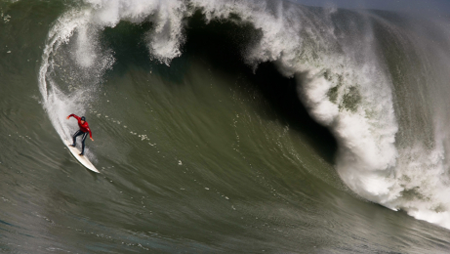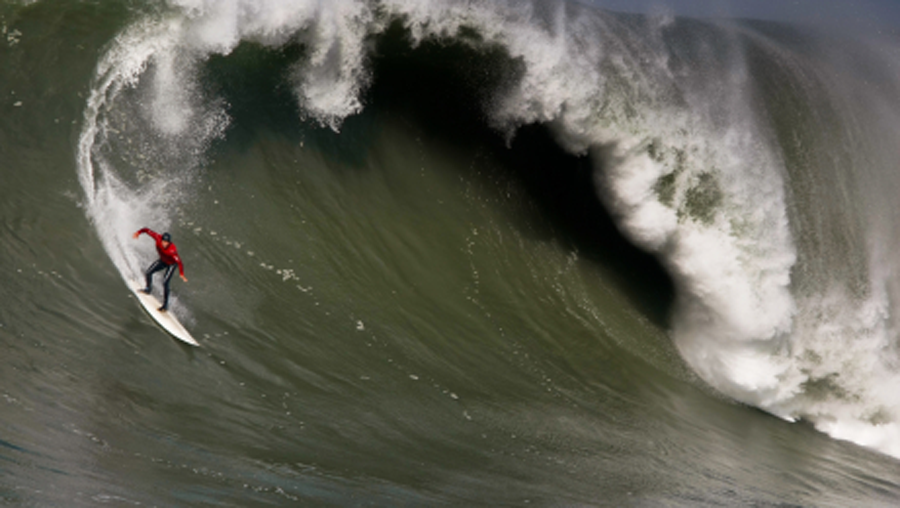Optical rogue waves on demand
Among the myriad of nonlinear optical effects, supercontinuum generation is perhaps the most visually stunning and useful in applications ranging from tomography to frequency metrology. When a high-intensity optical pulse propagates through a nonlinear dielectric medium, its spectrum broadens, with the degree of broadening depending on the strength of the interaction. If the interaction is strong enough (i.e., the interaction length is long or the intensity is high enough), then this spectral broadening can be dramatic, resulting in a supercontinuum (SC) whose width can include the entire visible spectrum. While SC can be produced in many different ways, the most common way today is to use a photonic crystal fiber, which has a small core to confine the light, resulting in a high intensity and low loss, allowing for long interaction lengths [1]. Despite the ease of generating SC, the dynamics behind it are extremely complicated, involving a cascade of different nonlinear effects. In a paper appearing in Physical Review Letters [2], Daniel Solli and Bahram Jalali from the University of California, Los Angeles, with Claus Ropers from the University of Göttingen in Germany have gone a long way towards clarifying the role that various nonlinear effects play. More importantly, they have shown that it is possible to control the relative importance of different nonlinear interactions, giving researchers control over the bandwidth and coherence properties of the supercontinuum, effectively allowing it to be used in ever more sophisticated ways.
In order to appreciate Solli’s work, it is worth placing it in context. In 2000, Ranka et al. [3] showed that photonic crystal fibers with small core and high effective nonlinearity could be used to generate a visible supercontinuum using the output from an ordinary titanium:sapphire laser. Photonic crystal fibers were key to this as they allowed long interaction lengths while confining light to a small core. Following this demonstration, detailed studies by many researchers (see the recent review by Dudley et al. [4] for more details) led to an understanding of the basic physics involved. It then became clear that the broadest supercontinuum was generated by the interaction of optical solitons (nondispersing nonlinear solitary waves that propagate stably for long distances), with the fiber mediated through the Raman effect. Once the basic physics was understood, work soon turned to an examination of the coherence properties of the SC, since a stable, coherent SC is necessary for many applications. It was then discovered that the coherence properties depended on the initial pulse width, with shorter input pulses typically producing more coherent output. The reason for this is that in the short pulse supercontinuum, the interacting solitons are produced via soliton fission from the initial pulse, whereas in the long pulse regime, the interacting solitons grow from noise due to parametric gain and modulational instability. Understanding the growth and noise properties of the long pulse supercontinuum has been an active area of research for Solli’s group in recent years and this current paper represents their latest efforts.
In an earlier work, Solli and co-workers showed that the amplitude noise of the optical supercontinuum had non-Gaussian statistics [5]. While this fact is perhaps not surprising, since almost any nonlinear process will transform a Gaussian distribution into a non-Gaussian one, this demonstration led to much activity in the field of optical rogue waves and succeeded in creating wide-spread interest in the physics of the supercontinuum process. Furthermore, it was shown both experimentally and theoretically that the broadest supercontinua were associated with the more extreme events (typing “optical rogue wave” into YouTube shows some interesting simulations of this). Thus in order to control the supercontinuum it was necessary to control these extreme events, and in their current paper, Solli and co-workers have found a particularly elegant way to do this.
Behind Solli’s work lies the realization that the optical rogue waves observed initially grow from noise and so one could hope to influence this process by injecting into the fiber a small seed pulse with the appropriate wavelength, along with the pump pulse that creates the supercontinuum. The seed pulse would then be amplified through nonlinear interactions with the pump pulse and in turn would create appropriate dispersive radiation leading to the broadest possible SC. This was first suggested by Dudley et al. in 2008 [6], who looked at a similar idea of introducing a small frequency modulation upon the pump pulse to control the SC. In order to test this idea it is necessary to have two short optical pulses at different frequencies launched simultaneously into a length of optical fiber. This was achieved by using an optical parametric oscillator that produced two pulses, a pump pulse at and a seed pulse at . The pump pulse was then amplified before being launched into the optical fiber, while the seed pulse was temporally stretched and then passed through a variable time delay generator before being launched into the fiber.
The importance of the temporal stretching is that afterwards, the pulse is chirped and so the different frequency components are separated in time. This fact, combined with the variable time delay, means that it is possible to control the seeding frequency for the generation of the rogue waves. This in turn makes it possible to control both the spectral extent and, most importantly, the noise in the supercontinuum, as the experimental results presented in Solli et al. paper make extremely clear [2]. They obtain a reduction in noise by almost compared to the unseeded case, while at particular frequencies on the long wavelength edge, the spectral density can be increased by almost . These experimental results can also be modeled accurately using a generalized nonlinear Schrödinger equation, showing that the physical understanding behind the experiment can be reproduced numerically.
Importantly, their work provides a roadmap for future work on SC generation, and perhaps provides clues towards rogue wave generation in other domains. Applications like optical coherence tomography rely on short pulses with a well-defined degree of coherence to create images from the interior of a scattering medium; being able to control the degree of coherence could have important applications in this field. In addition, being able to control the bandwidth of the SC would translate into an ability to control the resolution of the OCT system. Many researchers are keen to explore whether an optical SC could be compressed into an ultrashort pulse; again, a key factor will be the coherence of the SC, both pulse-to-pulse coherence as well as intrapulse coherence. Seeding the SC should ensure a better pulse-to-pulse coherence, making it easier to compress the SC. A drawback to the current procedure is the requirement for an optical parametric oscillator (OPO) to produce the two pulses. Such OPOs are bulky, typically have a low repetition rate, and are more expensive than mode-locked fiber lasers that can be used to produce SC in the femtosecond regime.
More speculatively, it is worth exploring what this work can tell us about wave dynamics in other systems. An attractive feature of the nonlinear Schrödinger equation is that it describes waves in many different material systems, from Bose-Einstein condensates to ocean waves. While the existence of oceanic rogue waves is well established, questions remain as to their formation and growth dynamics, hence an understanding of extreme events in the optical domain could translate into an understanding of oceanic waves, although, of course, there are a number of important differences (there is no direct optical equivalence between the forcing wind terms for water waves, nor an oceanic equivalent of the Raman terms that drive much of the optical rogue wave dynamics). While most sailors would want to inhibit the growth of rogue waves, perhaps it is not too farfetched to think of using “seed pulses” along with the current trend of artificial reefs to create the “perfect wave” for surfers (see Fig. 1). In this way the work of Solli et al. might find applications far removed from optical labs.
References
- Theodore Hansch described such fibers as “magical” in his Nobel Lecture in 2005 - probably the only time any physical device has been described as such by a Nobel laureate
- D. R. Solli, B. Jalali, and C. Ropers, Phys. Rev. Lett. 105, 233902 (2010)
- J. K. Ranka, R. S. Windeler, and A. J. Stentz, Opt. Lett. 25, No. 1, 25 (2000)
- J. M. Dudley, G. Genty, and S. Coen, Rev. Mod. Phys. 78, 1135 (2006)
- D. R. Solli, C. Ropers, P. Koonath, and B. Jalali, Nature 450, 1054 (2007)
- J. M. Dudley, G. Genty, and B. J. Eggleton, Opt. Express 16, No. 6, 3644 (2008)





